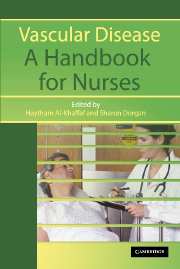6 - Training and Practice Issues
Published online by Cambridge University Press: 12 August 2009
Summary
THE ROLE OF THE VASCULAR NURSE SPECIALIST
Caring for patients with vascular disease is a complex and challenging area of care for all involved. The need for the provision of specialist nursing input to meet the requirements of vascular patients is now widely recognised. The role of the vascular nurse specialist can be divided into separate areas, all of equal importance. The areas I will be discussing can be divided into three sections as follows: education, advice and support, research and development.
EDUCATION
Education of patients and their relatives: The main emphasis being the provision of health education using research-based evidence. It is the role of the vascular nurse to assist patients to make lifestyle changes from the earliest stages of the disease. Once an initial assessment has been made and risk factors identified, it is necessary to plan, implement and evaluate appropriate, realistic interventions. In the case of patients with vascular disease this usually involves a number of different aspects of lifestyle including smoking cessation, good control of blood pressure and diabetes, advice on diet, cholesterol and exercise, and advice on good food care.
Education of staff: It is also the role of the vascular nurse to ensure the educational needs of nursing staff and other members of the multi-disciplinary team are met, by the provision of educational training and the teaching of clinical skills. It is important to identify training needs and plan regular training sessions to meet these requirements.
- Type
- Chapter
- Information
- Vascular DiseaseA Handbook for Nurses, pp. 221 - 248Publisher: Cambridge University PressPrint publication year: 2005



